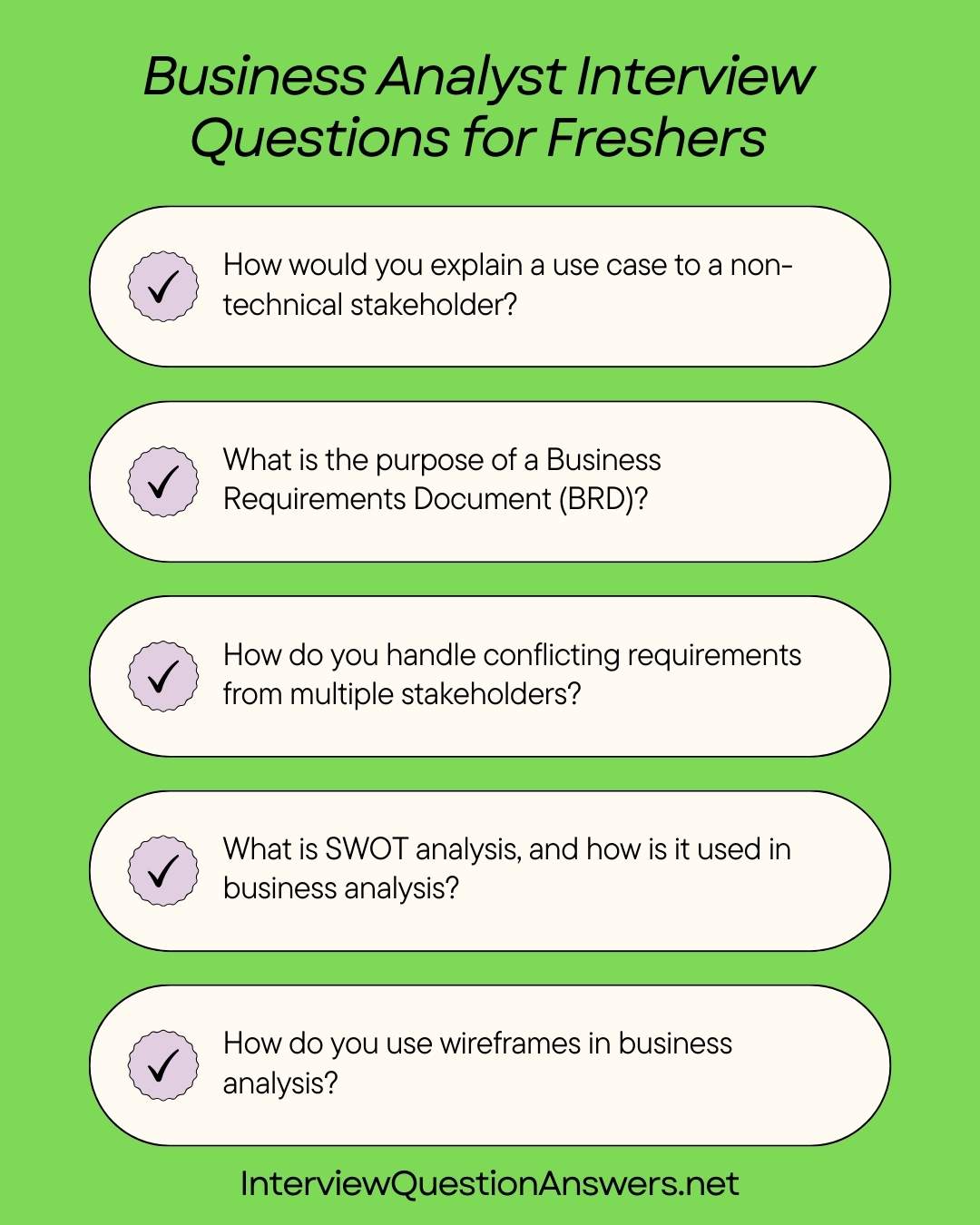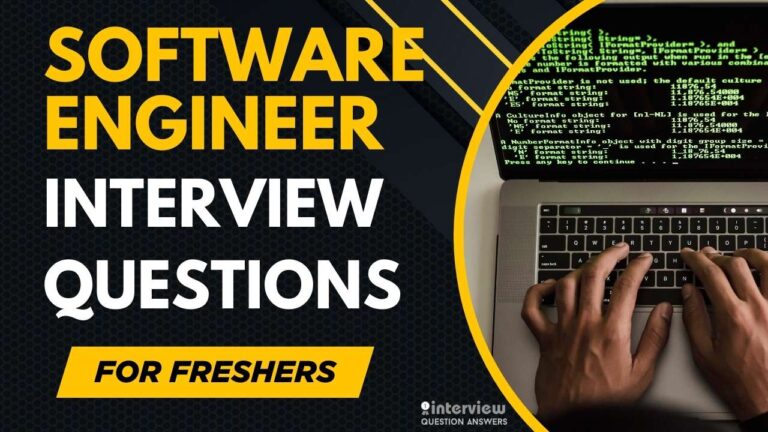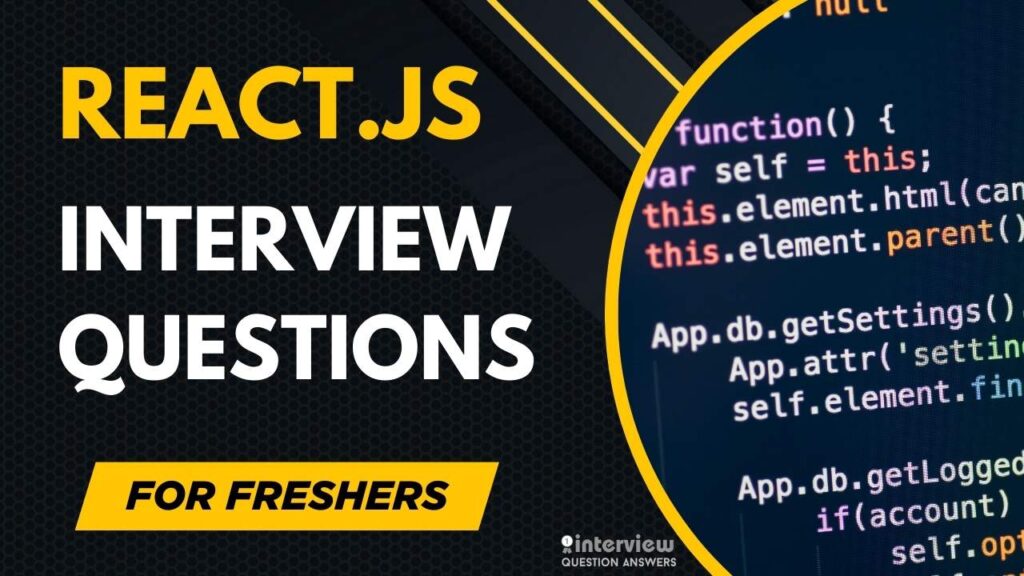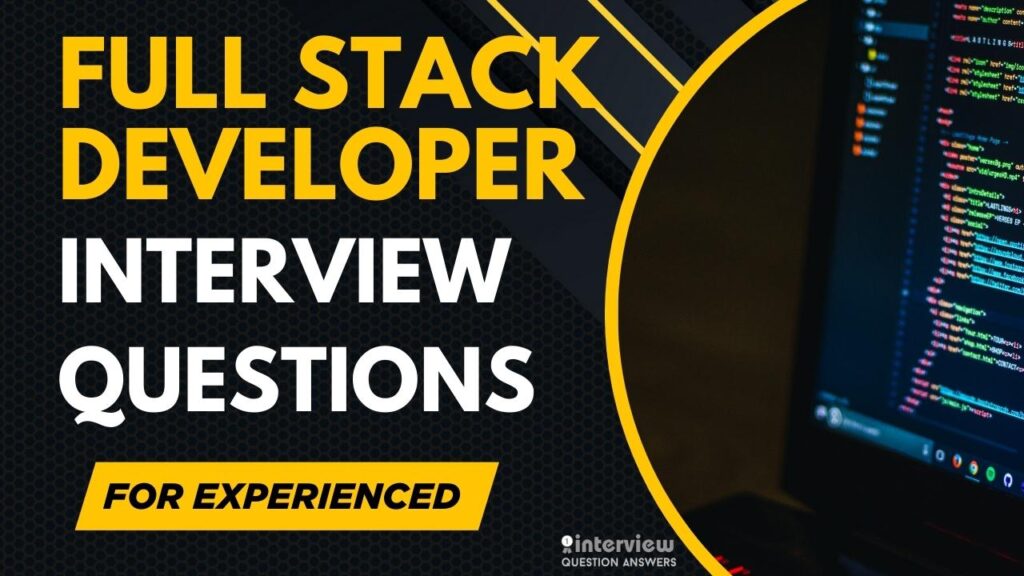Business Analyst Interview Questions for Freshers 2025
Business Analyst interview Questions guide helps new graduates and beginners prepare for Business Analyst job interviews with the most important questions that companies ask entry-level candidates. We included basic business analyst questions about requirement gathering, data analysis, and simple business problems that fresher positions focus on during hiring.
The Business Analyst Interview Questions guide covers everything from fundamental BA interview concepts and documentation skills to stakeholder communication and basic project management that employers test beginners on in interview rounds. We made sure to include Business Analyst Interview Questions about business processes, requirement analysis, and common tools that new business analysts need to understand for their daily work.
This guide helps fresh business analyst candidates practice the most commonly asked interview questions and get their first BA job with confidence.
You can also check our another similer guide here: Business Analyst Interview Questions PDF
Basic Business Analyst Interview Questions and Answers for Freshers
Que 1. What is the primary role of a Business Analyst in a project?
Answer: A Business Analyst (BA) bridges the gap between business stakeholders and technical teams by gathering, analyzing, and documenting requirements. They ensure that business needs are clearly translated into actionable specifications, facilitate communication, and support project delivery through testing and validation.
Que 2. What is the difference between a Business Requirement and a Functional Requirement?
Answer: Business Requirements define high-level business goals or needs, such as “increase sales by 10%.” Functional Requirements specify how the system achieves these goals, like “implement a shopping cart feature.” Business Requirements focus on “what” and Functional Requirements on “how.”
Que 3. How would you explain a use case to a non-technical stakeholder?
Answer: A use case is a description of how a user interacts with a system to achieve a specific goal, like logging into a website. It includes steps, actors (e.g., customer), and expected outcomes, making it easy for non-technical stakeholders to understand system functionality.
Que 4. What is a stakeholder, and how do you identify them?
Answer: Stakeholders are individuals or groups affected by or contributing to a project, such as clients, end-users, or developers. Identify them by reviewing project goals, organizational charts, and conducting interviews to ensure all relevant parties are included.
Que 5. What is a User Story, and how is it structured?
Answer: A User Story is a concise description of a feature from the user’s perspective, typically structured as: “As a [user], I want [functionality] so that [benefit].” For example, “As a customer, I want to reset my password so that I can regain account access.”
Example:
As a customer, I want to view my order history so that I can track past purchases.Que 6. What tools do Business Analysts commonly use for documentation and collaboration?
Answer: Common tools include JIRA for tracking requirements, Confluence for documentation, Microsoft Visio or Lucidchart for diagrams, and Excel for data analysis. Collaboration tools like Microsoft Teams or Slack are also used to communicate with stakeholders.
Que 7. What is the purpose of a Business Requirements Document (BRD)?
Answer: A BRD outlines the business objectives, needs, and high-level requirements for a project. It serves as a reference for stakeholders and guides the development team, ensuring alignment with business goals.
Que 8. How do you prioritize requirements in a project?
Answer: Prioritize requirements using techniques like MoSCoW (Must-have, Should-have, Could-have, Won’t-have) or by assessing business value, risk, and dependencies. Consult stakeholders to align priorities with project objectives.
Que 9. What is a process flow diagram, and why is it important?
Answer: A process flow diagram visually represents the steps in a business process, showing tasks, decisions, and flow. It’s important for identifying inefficiencies, clarifying workflows, and communicating processes to stakeholders.
Que 10. How do you handle conflicting requirements from multiple stakeholders?
Answer: Resolve conflicts by facilitating discussions, prioritizing based on business goals, and documenting trade-offs. Use workshops or interviews to align stakeholders and ensure transparency in decision-making.
Que 11. What is SWOT analysis, and how is it used in business analysis?
Answer: SWOT (Strengths, Weaknesses, Opportunities, Threats) analysis evaluates internal and external factors affecting a project or business. It helps identify strategic advantages and risks to inform decision-making.
Example:
**SWOT for Online Store**
- Strengths: Fast website
- Weaknesses: Limited inventory
- Opportunities: New market segments
- Threats: Competitor discountsQue 12. What is the difference between Agile and Waterfall methodologies?
Answer:
| Feature | Agile | Waterfall |
|---|---|---|
| Approach | Iterative, incremental | Linear, sequential |
| Flexibility | Adapts to changes | Rigid, changes difficult |
| Delivery | Frequent, small releases | Single final delivery |
Agile suits dynamic projects; Waterfall suits well-defined ones.
Que 13. What is a data flow diagram (DFD), and when is it used?
Answer: A DFD maps how data moves through a system, showing inputs, outputs, processes, and storage. It’s used to analyze and design system data flows, ensuring clarity for developers and stakeholders.
Que 14. How do you conduct a stakeholder interview effectively?
Answer: Prepare open-ended questions, listen actively, and take notes. Clarify ambiguous responses, confirm understanding, and follow up with summarized requirements to ensure accuracy and alignment.
Que 15. What is a Functional Specification Document (FSD)?
Answer: An FSD details the technical requirements and system behavior, including features, interfaces, and workflows. It guides developers in implementing solutions based on the BRD.
Que 16. How do you use wireframes in business analysis?
Answer: Wireframes are visual mockups of a system’s user interface, used to illustrate layout and functionality. They help stakeholders visualize the design and provide feedback before development.
Que 17. What is the purpose of a gap analysis in a project?
Answer: Gap analysis compares the current state of a system or process to the desired state, identifying gaps to address through solutions or improvements. It helps prioritize requirements and plan transitions.
Que 18. How do you ensure requirements are clear and testable?
Answer: Write requirements using clear, concise language, avoid ambiguity, and include acceptance criteria. Use tools like JIRA to track and validate requirements with stakeholders and testers.
Que 19. What is a business process model, and why is it useful?
Answer: A business process model is a visual or textual representation of workflows, showing tasks, roles, and outcomes. It’s useful for optimizing processes, training teams, and ensuring consistency.
Que 20. How do you handle a situation where a stakeholder is unclear about their requirements?
Answer: Use techniques like workshops, prototyping, or questionnaires to elicit details. Ask open-ended questions, provide examples, and iterate on drafts to clarify needs.
Que 21. What is the role of a BA in Agile projects?
Answer: In Agile, a BA works with the product owner to refine the backlog, write user stories, and clarify requirements during sprints. They facilitate communication between teams and stakeholders.
Que 22. What is a traceability matrix, and how is it used?
Answer: A traceability matrix links requirements to their sources, test cases, and deliverables, ensuring all requirements are addressed and validated. It tracks coverage and changes.
Example:
| Requirement ID | Source | Test Case |
|----------------|----------------|-----------|
| REQ001 | Stakeholder A | TC001 |Que 23. How do you use UML diagrams in business analysis?
Answer: UML (Unified Modeling Language) diagrams like use case, activity, or class diagrams model system behavior and structure. They help communicate requirements visually to technical and non-technical stakeholders.
Que 24. What is the purpose of a feasibility study in business analysis?
Answer: A feasibility study assesses whether a proposed solution is viable in terms of technical, financial, and operational aspects. It helps stakeholders decide whether to proceed with a project.
Que 25. How do you support user acceptance testing (UAT) as a Business Analyst?
Answer: Support UAT by creating test scenarios based on requirements, guiding users through testing, and documenting feedback. Ensure defects are tracked and resolved to meet stakeholder expectations.

Advanced Business Analyst Interview Questions and Answers for Freshers
Que 26. What is the role of a Business Analyst in ensuring data quality during a project?
Answer: A Business Analyst ensures data quality by defining data requirements, validating data sources, and collaborating with data teams to establish data cleansing rules. They document data quality metrics, such as accuracy and completeness, and work with stakeholders to resolve inconsistencies. For freshers in 2025, using tools like Excel or SQL to validate datasets is a practical starting point.
Que 27. How do you differentiate between a use case diagram and an activity diagram?
Answer:
| Feature | Use Case Diagram | Activity Diagram |
|---|---|---|
| Purpose | Shows actors and system interactions | Details process workflows |
| Components | Actors, use cases, relationships | Activities, decisions, flows |
| Focus | High-level functionality | Step-by-step process |
Use case diagrams outline “who” and “what,” while activity diagrams show “how.” Freshers should practice creating both in tools like Visio.
Que 28. What is a stakeholder analysis, and how do you perform one?
Answer: Stakeholder analysis identifies stakeholders, assesses their influence, and determines their needs. Perform it by listing stakeholders, evaluating their power/interest using a matrix, and prioritizing engagement strategies. For freshers in 2025, tools like PowerPoint or Miro can visualize the matrix effectively.
Example:
**Stakeholder Matrix**
- High Power, High Interest: Engage closely
- Low Power, Low Interest: MonitorQue 29. How do you use the MoSCoW prioritization technique in requirement gathering?
Answer: MoSCoW prioritizes requirements as Must-have, Should-have, Could-have, or Won’t-have. Work with stakeholders to classify requirements based on business impact and feasibility, ensuring critical features are delivered first. For freshers, documenting MoSCoW in JIRA or Excel ensures clarity.
Que 30. What is a data dictionary, and why is it important in business analysis?
Answer: A data dictionary defines data elements, their formats, and relationships in a system. It ensures consistency in data usage across teams. For freshers in 2025, creating a data dictionary in Confluence or Excel helps developers and testers understand data structures.
Que 31. How do you handle scope creep in a project?
Answer: Manage scope creep by clearly defining the project scope in the BRD, using a change request process, and communicating impacts to stakeholders. Regularly review requirements with the team to stay aligned. For freshers, tracking changes in JIRA prevents uncontrolled expansions.
Que 32. What is the purpose of a context diagram in business analysis?
Answer: A context diagram shows the system’s boundaries and interactions with external entities, like users or other systems. It provides a high-level view of scope and data flow, aiding stakeholder understanding. Freshers can use Lucidchart to create these.
Que 33. How do you create effective user stories for Agile projects?
Answer: Write user stories using the format: “As a [user], I want [functionality] so that [benefit].” Include acceptance criteria and ensure stories are small, testable, and valuable. For freshers in 2025, tools like Trello or JIRA help manage stories.
Example:
As a user, I want to log in so that I can access my account.
**Acceptance Criteria:**
- Login with valid credentials succeeds.
- Invalid credentials show an error.Que 34. What is a decision tree, and how is it used in business analysis?
Answer: A decision tree is a visual tool showing decisions, outcomes, and probabilities, used to analyze complex choices. It helps BAs evaluate options, like feature prioritization. Freshers can create decision trees in tools like Draw.io.
Que 35. How do you use prototyping in requirement gathering?
Answer: Prototyping creates mockups or interactive models to visualize system functionality. It helps elicit feedback, refine requirements, and validate designs. For freshers in 2025, tools like Figma or Balsamiq are ideal for creating prototypes.
Que 36. What is the role of a BA in backlog grooming in Agile?
Answer: In backlog grooming, a BA refines user stories, ensures clarity, adds acceptance criteria, and prioritizes tasks with the product owner. They clarify requirements to keep the backlog actionable. Freshers should practice this in sprint planning sessions.
Que 37. How do you conduct a root cause analysis for a business problem?
Answer: Use techniques like the 5 Whys or Fishbone Diagram to identify the underlying cause of a problem. Gather data, involve stakeholders, and document findings to propose solutions. For freshers, tools like Miro support collaborative analysis.
Que 38. What is an entity-relationship diagram (ERD), and when is it used?
Answer: An ERD visually represents database entities, attributes, and relationships. It’s used to design or document data models, ensuring alignment with business needs. Freshers can create ERDs using tools like MySQL Workbench.
Que 39. How do you facilitate a requirements workshop effectively?
Answer: Plan the agenda, invite relevant stakeholders, use visual aids like whiteboards, and encourage participation. Summarize outcomes and share documented requirements. For freshers in 2025, practicing facilitation skills in mock workshops is key.
Que 40. What is the purpose of a cost-benefit analysis in a project?
Answer: A cost-benefit analysis evaluates the financial and operational benefits of a project against its costs to justify investment. It helps stakeholders make informed decisions. Freshers can use Excel for simple calculations.
Que 41. How do you use a RACI matrix in business analysis?
Answer: A RACI matrix (Responsible, Accountable, Consulted, Informed) defines roles and responsibilities for project tasks. It clarifies who does what, reducing confusion. For freshers, creating a RACI in Excel ensures team alignment.
Example:
| Task | PM | BA | Developer |
|--------------|------|------|-----------|
| Requirements | A | R | C |Que 42. What is business process reengineering (BPR), and how does a BA contribute?
Answer: BPR involves redesigning processes to improve efficiency or performance. A BA maps current processes, identifies bottlenecks, and proposes optimized workflows. For freshers, documenting “as-is” and “to-be” processes in Visio is a starting point.
Que 43. How do you use data modeling in business analysis?
Answer: Data modeling defines how data is structured and related, using tools like ERDs or UML class diagrams. It ensures systems meet business data needs. Freshers should practice modeling in tools like Lucidchart.
Que 44. What is the role of a BA in risk analysis for a project?
Answer: A BA identifies project risks, assesses their impact, and proposes mitigation strategies. They document risks in a risk register and collaborate with stakeholders to monitor them. For freshers in 2025, Excel or JIRA can track risks.
Que 45. How do you use BPMN (Business Process Model and Notation) in business analysis?
Answer: BPMN standardizes process modeling with symbols for tasks, events, and gateways. It’s used to map workflows clearly for stakeholders. Freshers can use tools like Bizagi or Lucidchart to create BPMN diagrams.
Que 46. What is the difference between a sprint and an iteration in Agile?
Answer: A sprint is a time-boxed iteration in Scrum (typically 2-4 weeks) where a set of tasks is completed. Iteration is a broader Agile term for any repeated development cycle. Both aim for incremental delivery, but sprints are Scrum-specific.
Que 47. How do you ensure traceability of requirements in a project?
Answer: Use a traceability matrix to link requirements to their sources, test cases, and deliverables. It ensures all requirements are addressed and validated. For freshers, maintaining this in JIRA or Excel is practical.
Que 48. What is the purpose of a stakeholder communication plan?
Answer: A stakeholder communication plan outlines how and when to communicate with stakeholders, including methods (e.g., email, meetings) and frequency. It ensures alignment and transparency. Freshers can create plans in Excel or Confluence.
Que 49. How do you use a PESTLE analysis in business analysis?
Answer: PESTLE (Political, Economic, Social, Technological, Legal, Environmental) analysis evaluates external factors impacting a project. It helps BAs understand risks and opportunities. For freshers, presenting PESTLE in PowerPoint aids stakeholder discussions.
Que 50. What is the role of a BA in change management during a project?
Answer: A BA supports change management by documenting change requests, assessing their impact on scope and resources, and communicating changes to stakeholders. They ensure changes align with business goals. For freshers, using JIRA for change tracking is effective.













